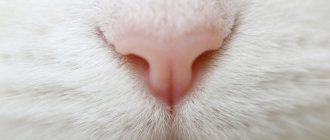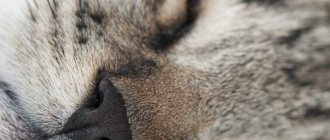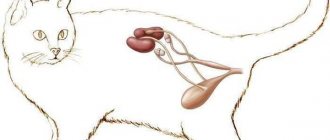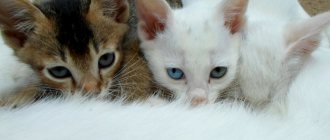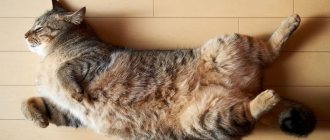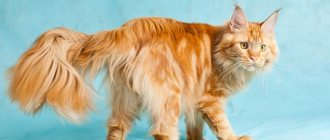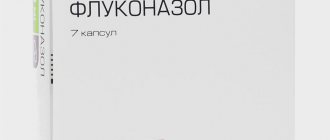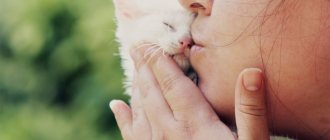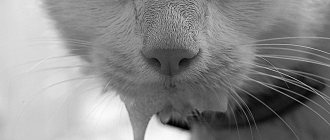An owner who cares for his pet should determine his well-being by the appearance of the animal. A cat's wet nose is considered a sign of health. The condition of the tip of a cat's nose is some indicator of the health or illness of the animal. A more accurate diagnosis, of course, can only be made by a veterinarian, whom you should contact if you suspect a disease.
general information
A cat's nose consists of two nasal canals separated by cartilage. The drawn air enters the nasal chambers, from which it enters the winding channels. In these channels, the smell is purified from foreign impurities, which allows the cat to recognize the nature of the smell.
cat nose
Special cells associated with the olfactory region of the brain are responsible for recognizing odors. The nasal sinuses perform not only the function of smell, but also thermoregulatory and filtering. The air drawn in has time to heat up to the required temperature and be cleaned of the smallest molecules of dust and bacteria.
The area accessible to human touch that is mistaken for the animal's nose is actually the skin around the nostrils and is called the lobe. It is by this that the owner judges the health status of the pet. A healthy cat's nose should be moist, cool and rough. But not noticeably wet and cold.
Why is my nose cool?
One of the main functions of the nasal lobe is the animal's thermoregulation. The lack of sweat glands in a cat's body means that cooling of the body in hot conditions occurs through the nasal cavity and open mouth, so the nose is cool.
Thermoregulation through the nose and open mouth
Deviation from the norm indicates possible pathological processes in the cat’s body, for example, a warm nose lobe indicates an increase in body temperature and a possible fight of the immune system against viruses or bacteria.
Why does a cat have a wet nose?
A moistened surface makes it easier for a cat to catch and recognize odors around; other animals, such as dogs, also have a similar feature.
Wet nose close up
Constant moisture of the nose and its color as an indicator of health
Stable moisture indicates good health of the pet. Based on the color of the organ, the condition of the patient is judged as follows:
- A smooth, cool, moist pink nose on a healthy cat.
- White indicates problems with the circulatory system.
- A red tint with pronounced signs of inflammation and excess mucus indicates rhinitis.
- Blueness of a wet or dry organ is the first sign of heart disease or lack of oxygen.
- Strong yellowness in humidity indicates problems with the liver and kidneys.
Symptoms of the disease
A very wet nose in a cat is most often a symptom of colds or acute respiratory diseases. Symptoms that usually accompany a cold are increased body temperature, decreased appetite or complete refusal to eat, and low physical activity. At the same time, the coat loses its well-groomed shine, redness of the mucous membranes and tearing are possible.
Why do cats wag their tail: what does it mean?
A pet with a cold becomes capricious, like a child, and less often aggressive. He sneezes, coughs and rubs his nose with his paws, constantly trying to warm up by the radiator, under a blanket or in the arms of his owner. Colds are rare among cats, as their bodies easily cope with such pathogens.
The following can undermine a cat’s immune defense:
- high humidity and drafts in the room;
- constant deficiency of beneficial microelements due to an unbalanced diet;
- hypothermia due to walking in rainy weather;
- Wool that is not completely dry after washing.
A pet with a cold needs to be given rest and plenty of fluids. For example, warm milk, low-fat broth and water work well. It is recommended to alleviate the symptoms: blot your eyes with a cotton pad soaked in boiled water and remove nasal discharge.
Important! If the cat does not cope with the disease within 24 hours, it is necessary to seek advice from a veterinary clinic, where treatment will be prescribed (in especially advanced cases, antibiotics).
A very cold nose in a cat may be a sign of an illness occurring in the body, but there must also be some other symptoms, for example, vomiting, diarrhea, a lethargic and apathetic state, decreased or lack of appetite.
Signs that your cat is sick:
- A raw nose due to heavy discharge and hot ears are symptoms of an ongoing infection (rhinotracheitis, panleukopenia, etc.)
- Copious nasal discharge with traces of blood or pus is most often the result of a foreign body entering the nasal canal.
- Excessive nasal discharge and tearing are symptoms of a cat’s allergic reaction to recently introduced foods, household chemicals, medications, pollen, dust, tobacco smoke, etc.
- A cat's wet and cold nose, accompanied by a drop in body temperature, may be a sign of hypothermia or toxic poisoning.
Colds in cats
- A cat's wet nose, wheezing when inhaling air, or breathing through the mouth indicate the presence of polyp growths or damage to the mucous membrane inside the organ.
- A cold and pale nose can be a symptom of anemia or other blood problems, a bluish tint to the skin of the nose indicates cardiovascular insufficiency, and a yellowish color indicates liver or kidney problems.
- A cold, dry nose with possible hair loss and decreased physical activity is a consequence of weakened immunity, which is caused by an unbalanced diet. Eating only dry food over time causes dehydration and malfunction of internal organs. Cats are hunters by nature and require meat in their diet.
Cat nasal discharge
Note! If you notice that your cat is leaking suspicious fluid from his nose, is having difficulty breathing, is sniffling or wheezing, consult a veterinarian who will make a diagnosis and prescribe the correct treatment.
Norm or pathology
The sense of smell in cats is the main sense organ.
An animal that has difficulty smelling becomes lethargic, has poor spatial orientation, and loses its appetite. If the olfactory organ is moist and cool, this means that the pet is healthy .
Due to the emotional state, physical activity, and climatic conditions, indicators can change over time, but this is not always a sign of pathology.
Minor dryness goes away on its own or after favorable conditions are created.
Important. Even overeating or eating a small portion of food can affect humidity.
Pets on dry food are more likely to have health problems. To improve their condition, they need plenty of fluids; if there is no desire, the animal can be fed from a syringe without a needle.
If deviations in the cat’s behavior, lethargy and apathy are noticed, then he should be monitored for 2 days. During this period, in the absence of diseases, the moisture in the nose is restored.
Many people believe that sick cats' noses become dry and hot. This is not entirely true. Sometimes an animal is diagnosed with a wet nose, but other signs indicate the presence of pathology. In this case, consultation with a veterinarian is required.
Nasal care
Why do cats bury food - next to the bowl and what does this mean?
A healthy adult cat can handle hygiene, including its nose, on its own. An increase in ambient temperature makes the cat want to lick itself more often and drink more to moisten its nose. When small debris or dust gets in, some cats try to clean their nose by wiping it on grass or leaves.
Representatives of flat-faced breeds, such as Persians, need help with nasal hygiene. As a result of selection, changes occurred in the anatomical proportions of the skull, which caused a disruption of the cartilaginous septum inside the organ. That is why in such cats a crust grows on top or nearby or excessive moisture appears.
Help with nasal hygiene for Persians
You can remove dirt and remaining snot by gently moving a cotton swab or disk soaked in cooled boiled water. After cleansing, excess moisture is removed from the earlobe with a gentle, gentle movement; this will help avoid the occurrence of rhinitis when staying in cool rooms. A small kitten may also require similar care if it is separated early from its mother, who has not yet taught it how to care for itself.
Removing nasal discharge with a damp cotton pad
The use of alcohol-based or scented wet wipes to wipe away nasal secretions is strictly prohibited, as they can cause dry mucous membranes or an allergic reaction. If damage is detected on the surface of the nose (scratches, cracks, abrasions), it is prohibited to treat them with iodine or brilliant green. Concentrated alcohol in such products increases the likelihood of getting a burn, which results in swelling and difficulty breathing for the cat.
Important! When clearing your cat's nasal lobe of dirt or secretions due to congestion, do not get inside the nasal canals. Only the visible part needs to be processed.
A cat's wet nose is not always a guarantee of its health. Noticing symptoms in a timely manner and contacting a specialist will help avoid the development of chronic diseases.
Tool for combing the hair of cats and dogs My Rules (deshedder, comb, slicker) size M
711 ₽ More details
History of Russia for children. Book Butromeev V.P. | Butromeev Vladimir Petrovich
888 ₽ More details
Dog houses
Excessive humidity
Allocations must be standardized. Any decrease or increase in them should alert the owners . Snorting and difficult breathing against a background of humidity may indicate the presence of polyps or damage to the inner surface of the nasal passages.
An excessively cold and wet organ is a sign of hypothermia or poisoning. A cold is suspected when there is a rise in temperature, sneezing, or excessive discharge.
High humidity is normal for Persians and other breeds with flattened faces.
Reasons for deviations
Deviations may occur in the direction of dryness or increased humidity of the nose, both of which can be warning signs of complications.
Excessive nasal dryness may indicate:
- lack of fluid in the body;
- respiratory tract infections;
- diseases of internal organs and inflammation;
- together with elevated ear temperature can cause ear mites.
Excessive fluid discharge may be a consequence of such common diseases;
- inflammation of the gums and teeth;
- chronic rhinusitis;
- the formation of polyps on the mucous membrane, usually with characteristic difficulty breathing;
- hypothermia of the body;
- allergic reactions;
- chemical poisoning.
Strong odors that are not so noticeable to humans, such as ammonia, cigarette smoke, and disinfectants, can irritate the mucous membrane, causing excessive moisture release.
Why does a dog need a nose?
The front part of the nostril is responsible for inhaling air, while the task of these slits on the sides is to remove air during exhalation. As air flows out of the side slots, it creates vortexes that help with the selection of new odors by creating a flow of air over them.
Interesting materials:
Where to relax in Russia at sea 2022? Where to visit in November in Russia? Where are passenger cars produced in Russia? Where are cars made in Russia? Where is the border between Russia and Japan? Where is the border between Russia and China? Where do Jews live in Russia? Where do Kazakhs live in Russia? Where do the Nogais live in Russia? Where do Russians live in Russia?
Prevention
After diagnosis and further treatment, it is necessary to adhere to certain preventive measures to avoid relapse.
Watch what you feed your animal. Check his mouth regularly for injuries or foreign bodies.
If treatment for fleas is planned, then strictly follow the instructions on the drug. Apply flea drops to places where the animal does not touch its tongue when washing itself. If the animal is too active, then use a special cap for cats. Store all chemicals, cosmetics and household products for the home in locked places.
It is important to carefully monitor so that your pet cannot climb into these places. It’s better to use these products when your pet is not around
If your pet's problems are related to teeth, you need to brush your pet's teeth regularly.
For this purpose, pet stores sell special products and treats. By the way, cats also have milk teeth.
Prevention
Black dots on a furry pet’s nose appear for a variety of reasons (physiological, pathological), among which are:
- breed, genetic predisposition;
- exposure to sunlight;
- metabolic failures;
- hormonal imbalance;
- errors in feeding, improper care;
- endocrine pathologies, chronic diseases;
- sudden change in diet;
- stress, emotional turmoil;
- violation of hygiene rules, feeding from dirty bowls;
- tendency to allergies;
- a sharp change in diet, switching to new foods;
- dermatological problems (contact, chronic, atypical, infectious dermatitis caused by viruses, fungi);
- mycoses;
- problems in the functioning of the liver and pancreas.
We suggest you familiarize yourself with the cat breathing with its mouth open after giving birth: causes and consequences
As a rule, the mechanism for the appearance of black dots on the nose of cats is associated with an excess, enhanced production of the melanin pigment (responsible for the dark color). Spots on the lobe most often appear with age and are very rare in young kittens.
As for breed predisposition, black spots on the nose can be found in Sphynxes, Devonrexes, Abbishinos, Siamese, Persian, and Himalayan cats.
Acne in cats
- Genetic predisposition can lead to increased activity of the sebaceous glands, which increases the risk of acne. In this case, you need to regularly use products that dry and cleanse the skin.
- Plastic food and water bowls, due to their porous structure, become a breeding ground for bacteria that cause infection and inflammation of the skin of the chin. There have been cases when replacing them with stainless steel containers completely solved the problem of rashes on the face. There is an assumption that the appearance of acne may also be an allergic reaction to plastic. Acne can also appear as a result of food allergies.
- Stress causes the release of adrenaline and cortisol, which stimulate the sebaceous glands, creating fertile ground for the formation of acne and pimples.
- Unbalanced diet. The appearance of black dots should be a signal to revise the diet towards reducing fat and enriching the diet with vitamins.
- It is difficult for a cat to keep its chin clean on its own. Washing with warm water after eating will remove the problem of contamination. Your pet's dishes should be washed daily with hot water and soapy water.
As can be seen from the list, it is impossible to say exactly why acne occurs, but compliance with sanitary rules is of primary importance both for prevention and during treatment. You can get rid of blackheads at home using warm lotions with tinctures of medicinal herbs (chamomile, celandine, yarrow).
To treat acne at the inflammatory stage, modern broad-spectrum antiseborrheic ointments and gels containing 2.5–5% benzoyl peroxide (for example, OxyDex) are used. Preparations with salicylic acid (Stri-dex, Clearasil) are also used. In severe cases, a scraping of the bacterial culture is taken and a course of antibiotics is prescribed. Your veterinarian can perform a cleaning to speed up recovery.
The nose is one of those organs that undeservedly remains in the shadows when the owner examines the animal. Of course, cats are able to monitor the condition of their nose on their own and lick it when it gets dry. However, there are situations that trigger long-term inflammatory processes that the cat cannot influence.
Even the owner can detect neoplasms such as polyps and quickly take appropriate measures
In this regard, a weekly nasal examination, even in the absence of cold symptoms, will be an excellent way to prevent respiratory diseases. Periodic examinations and palpating of your pet’s nose can protect him from advanced illnesses. You can check your pet's nose by touching it with the back of your hand.
All manipulations carried out with the cat must be done with clean hands.
In addition to diagnostics, it is acceptable to clean your cat’s nose from time to time. If you are ready to deal with your pet's protest and calm him throughout the procedure, then the tips presented below will help you make the cleansing process easier.
How to clean a cat's nose
